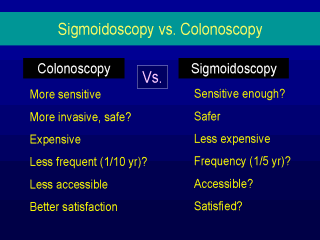 |
Go to Part II of this lecture This is where I see the comparison of sigmoidoscopy versus
colonoscopy. Colonoscopy is more sensitive, definitely. Itís going to pick up more and
looks further. Sigmoidoscopy is maybe 85% as sensitive as colonoscopy. Colonoscopy is more
invasive so sigmoidoscopy is safer, although every sigmoidoscopy that is a positive means
the patient needs to have a colonoscopy, which is added risk. Colonoscopy is much more
expensive. One of the big appeals of colonoscopy is they say that you only need one every
ten years if you have one and itís negative. The truth is that we have no data on
whether ten years is adequate. Just looking at the PLCO trial, among people who have had a
negative flex sig and then came back three years later for repeat flex sig, weíre
finding about 1% incidence of advanced adenomas cancers. It is highly likely then that if
you tell someone to have a colonoscopy once every ten years, some people will then be sent
away and told theyíre alright when theyíre really not. Sigmoidoscopy is now targeted
at one every five years. Again, we donít know if thatís sufficient. Colonoscopy can
only be done by specialized people who are trained in the procedure. Sigmoidoscopy is much
more accessible. I think the patient may feel more satisfied with colonoscopy. They get
drugs for the procedure, they have the notion that theyíve totally purged the colon, had
their complete colon examined, and now donít need anything for ten years. I think there
is less satisfaction with sigmoidoscopy, although Iíll show you some data that shows
itís really very well tolerated and people like it.
 |
Go to Comment Form |
|
